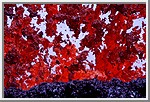













|
The Nature of Volcanoes
| Table of Contents |
|
Introduction Movies of Volcanoes Views of Terrestrial Volcanoes References The Nature of Volcanoes Principal Types of Volcanoes |
| Volcanoes |
|
Hawaiian Volcanoes Resurgent Calderas and the Valles Caldera Additional Images & Animations |
| Internet Resources |
|
USGS Volcano Hazards Volcano World Home Page EOS Volcanology |
Driven by buoyancy and gas pressure the molten rock, which is lighter than the surrounding solid rock forces its way upward and may ultimately break though zones of weaknesses in the Earth's crust. If so, an eruption begins, and the molten rock may pour from the vent as non-explosive lava flows, or may shoot violently into the air as dense clouds of lava fragments. Larger fragments fall back around the vent, and accumulations of fall-back fragments may move downslope as ash flows under the force of gravity. Some of the finer ejected materiaIs may be carried by the wind only to fall to the ground many miles away. The finest ash particles may be injected miles into the atmosphere and carried many times around the world by stratospheric winds before settling out.
Molten rock below the surface of the Earth that rises in volcanic vents is known as magma, but after it erupts from a volcano it is called Clava. Originating many tens of miles beneath the ground, the ascending magma commonly contains some crystals, fragments of surrounding (unmelted) rocks, and dissolved gases, but it is primarily a liquid composed principally of oxygen, silicon, aluminum, iron, magnesium, calcium, sodium, potassium, titanium, and manganese. Magmas also contain many other chemical elements in trace quantities. Upon cooling, the liquid magma may precipitate crystals of various minerals until solidification is complete to form an igneous or magmatic rock.
Heat concentrated in the Earth's upper mantle raises temperatures sufficiently to melt the rock locally by fusing the materials with the lowest melting temperatures, resulting in small, isolated blobs of magma. These blobs then collect, rise through conduits and fractures, and some ultimately may re-collect in larger pockets or reservoirs ("holding tanks") a few miles beneath the Earth's surface. Mounting pressure within the reservoir may drive the magma further upward through structurally weak zones to erupt as lava at the surface. In a continental environment, magmas are generated in the Earth's crust as well as at varying depths in the upper mantle. The variety of molten rocks in the crust, plus the possibility of mixing with molten materials from the underlying mantle, leads to the production of magmas with widely different chemical compositions.
If magmas cool rapidly, as might be expected near or on the Earth's surface, they solidify to form igneous rocks that are finely crystalline or glassy with few crystals. Accordingly, lavas, which of course are very rapidly cooled, form volcanic rocks typically characterized by a small percentage of crystals or fragments set in a matrix of glass (quenched or super-cooled magma) or finer grained crystalline materials. If magmas never breach the surface to erupt and remain deep underground, they cool much more slowly and thus allow ample time to sustain crystal precipitation and growth, resulting in the formation of coarser grained, nearly completely crystalline, igneous rocks. Subsequent to final crystallization and solidification, such rocks can be exhumed by erosion many thousands or millions of years later and be exposed as large bodies of so-called granitic rocks, as, for example, those spectacularly displayed in Yosemite National Park and other parts of the majestic Sierra Nevada mountains of California.
 Lava is red hot when it pours or blasts out of a vent but soon changes to dark red, gray,
black, or some other color as it cools and solidifies. Very hot, gas-rich lava containing
abundant iron and magnesium is fluid and flows like hot tar, whereas cooler, gas-poor
lava high in silicon, sodium, and potassium flows sluggishly, like thick honey in some
cases or in others like pasty, blocky masses.
Lava is red hot when it pours or blasts out of a vent but soon changes to dark red, gray,
black, or some other color as it cools and solidifies. Very hot, gas-rich lava containing
abundant iron and magnesium is fluid and flows like hot tar, whereas cooler, gas-poor
lava high in silicon, sodium, and potassium flows sluggishly, like thick honey in some
cases or in others like pasty, blocky masses.
All magmas contain dissolved gases, and as they rise to the surface to erupt, the confining pressures are reduced and the dissolved gases are liberated either quietly or explosively. If the lava is a thin fluid (not viscous), the gases may escape easily. But if the lava is thick and pasty (highly viscous), the gases will not move freely but will build up tremendous pressure, and ultimately escape with explosive violence. Gases in lava may be compared with the gas in a bottle of a carbonated soft drink. If you put your thumb over the top of the bottle and shake it vigorously, the gas separates from the drink and forms bubbles. When you remove your thumb abruptly, there is a miniature explosion of gas and liquid. The gases in lava behave in somewhat the same way. Their sudden expansion causes the terrible explosions that throw out great masses of solid rock as well as lava, dust, and ashes.
The violent separation of gas from lava may produce rock froth called pumice. Some of this froth is so light--because of the many gas bubbles--that it floats on water. In many eruptions, the froth is shattered explosively into small fragments that are hurled high into the air in the form of volcanic cinders (red or black), volcanic ash (commonly tan or gray), and volcanic dust. (Abstracted from Tillings)
Copyright © 1997-2000 by Calvin J. Hamilton. All rights reserved. Privacy Statement.